Data Analysis and Visualization Report: COVID-19 Infection Rates in UK
VerifiedAdded on 2023/01/04
|16
|2302
|76
Report
AI Summary
This report presents an analysis of COVID-19 infection rates among white and BAME (Black, Asian, and Minority Ethnic) patients in the UK, based on a dataset of 50 individuals. The analysis begins with descriptive statistics, including mean, median, mode, standard deviation, and frequency distributions f...

ACCB4002 Data Analysis and Visualization
Paraphrase This Document
Need a fresh take? Get an instant paraphrase of this document with our AI Paraphraser
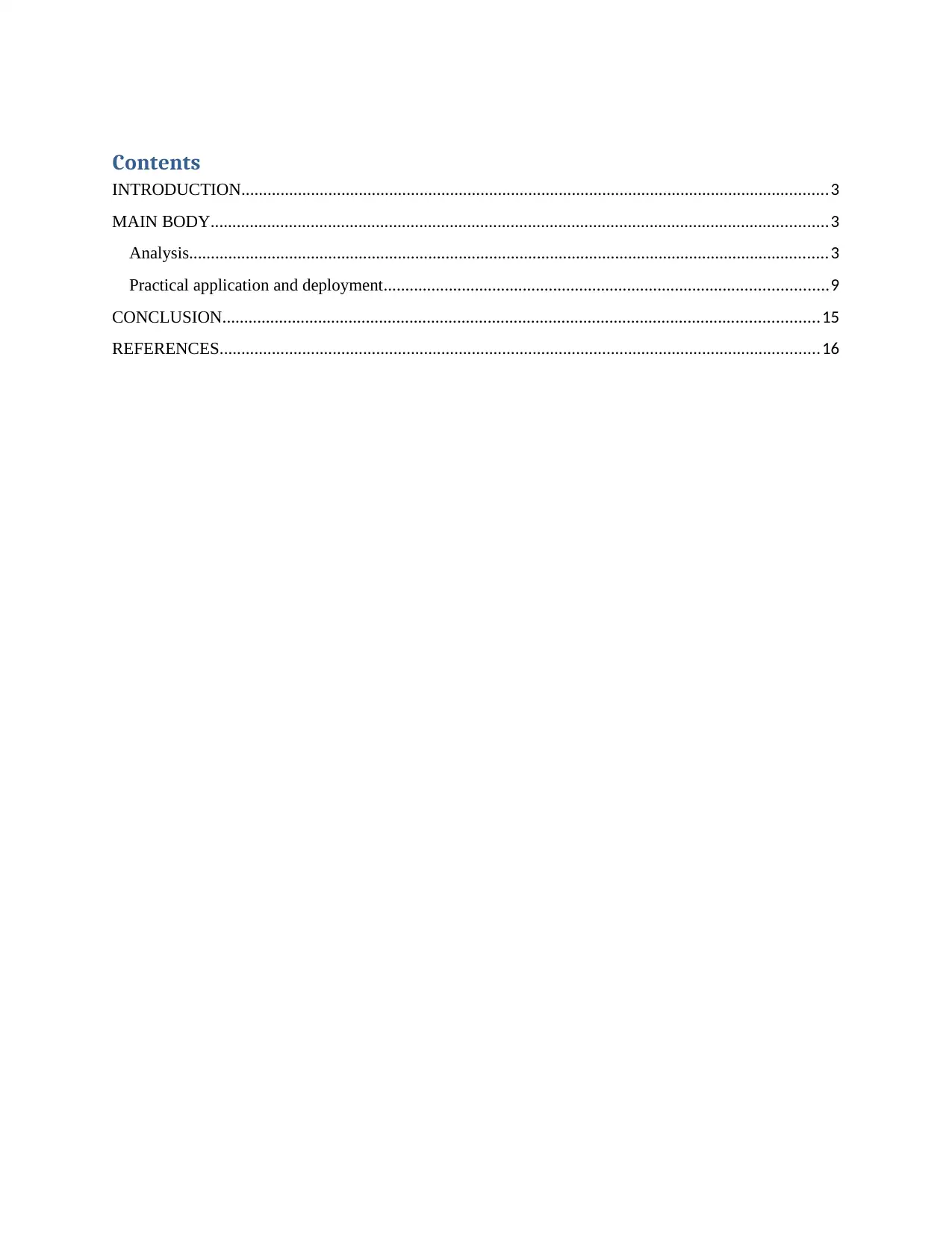
Contents
INTRODUCTION.......................................................................................................................................3
MAIN BODY..............................................................................................................................................3
Analysis...................................................................................................................................................3
Practical application and deployment......................................................................................................9
CONCLUSION.........................................................................................................................................15
REFERENCES..........................................................................................................................................16
INTRODUCTION.......................................................................................................................................3
MAIN BODY..............................................................................................................................................3
Analysis...................................................................................................................................................3
Practical application and deployment......................................................................................................9
CONCLUSION.........................................................................................................................................15
REFERENCES..........................................................................................................................................16
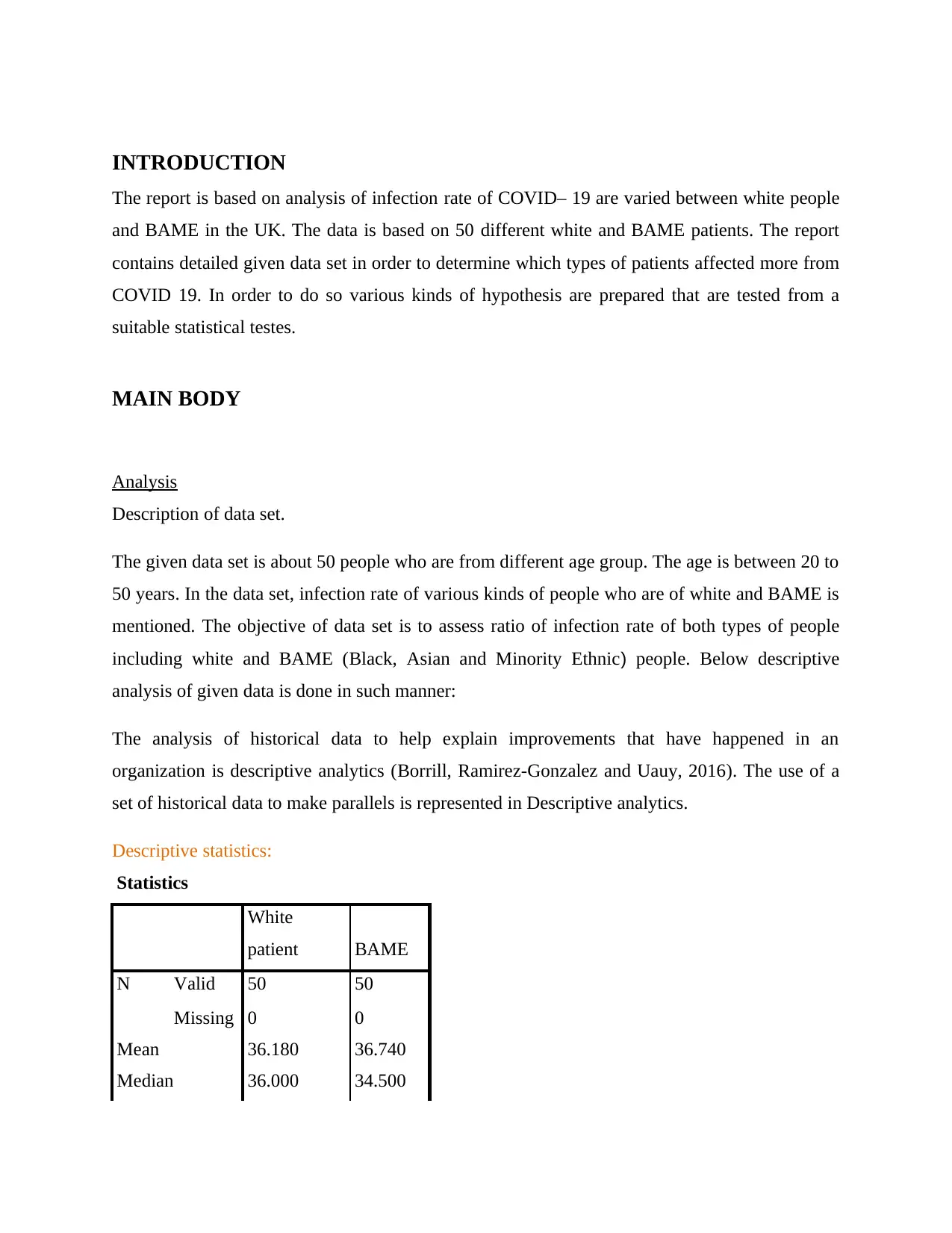
INTRODUCTION
The report is based on analysis of infection rate of COVID– 19 are varied between white people
and BAME in the UK. The data is based on 50 different white and BAME patients. The report
contains detailed given data set in order to determine which types of patients affected more from
COVID 19. In order to do so various kinds of hypothesis are prepared that are tested from a
suitable statistical testes.
MAIN BODY
Analysis
Description of data set.
The given data set is about 50 people who are from different age group. The age is between 20 to
50 years. In the data set, infection rate of various kinds of people who are of white and BAME is
mentioned. The objective of data set is to assess ratio of infection rate of both types of people
including white and BAME (Black, Asian and Minority Ethnic) people. Below descriptive
analysis of given data is done in such manner:
The analysis of historical data to help explain improvements that have happened in an
organization is descriptive analytics (Borrill, Ramirez-Gonzalez and Uauy, 2016). The use of a
set of historical data to make parallels is represented in Descriptive analytics.
Descriptive statistics:
Statistics
White
patient BAME
N Valid 50 50
Missing 0 0
Mean 36.180 36.740
Median 36.000 34.500
The report is based on analysis of infection rate of COVID– 19 are varied between white people
and BAME in the UK. The data is based on 50 different white and BAME patients. The report
contains detailed given data set in order to determine which types of patients affected more from
COVID 19. In order to do so various kinds of hypothesis are prepared that are tested from a
suitable statistical testes.
MAIN BODY
Analysis
Description of data set.
The given data set is about 50 people who are from different age group. The age is between 20 to
50 years. In the data set, infection rate of various kinds of people who are of white and BAME is
mentioned. The objective of data set is to assess ratio of infection rate of both types of people
including white and BAME (Black, Asian and Minority Ethnic) people. Below descriptive
analysis of given data is done in such manner:
The analysis of historical data to help explain improvements that have happened in an
organization is descriptive analytics (Borrill, Ramirez-Gonzalez and Uauy, 2016). The use of a
set of historical data to make parallels is represented in Descriptive analytics.
Descriptive statistics:
Statistics
White
patient BAME
N Valid 50 50
Missing 0 0
Mean 36.180 36.740
Median 36.000 34.500
You're viewing a preview
Unlock full access by subscribing today!

Mode 20.0a 50.0
Std. Deviation 9.4192 9.3171
Variance 88.722 86.809
a. Multiple modes exist. The smallest
value is shown
White patient
Frequency Percent
Valid
Percent
Cumulative
Percent
Valid 20.0 4 8.0 8.0 8.0
22.0 2 4.0 4.0 12.0
25.0 2 4.0 4.0 16.0
26.0 1 2.0 2.0 18.0
27.0 2 4.0 4.0 22.0
28.0 1 2.0 2.0 24.0
29.0 1 2.0 2.0 26.0
30.0 2 4.0 4.0 30.0
32.0 1 2.0 2.0 32.0
33.0 4 8.0 8.0 40.0
34.0 2 4.0 4.0 44.0
35.0 3 6.0 6.0 50.0
37.0 2 4.0 4.0 54.0
38.0 2 4.0 4.0 58.0
40.0 4 8.0 8.0 66.0
42.0 1 2.0 2.0 68.0
43.0 4 8.0 8.0 76.0
44.0 3 6.0 6.0 82.0
45.0 1 2.0 2.0 84.0
Std. Deviation 9.4192 9.3171
Variance 88.722 86.809
a. Multiple modes exist. The smallest
value is shown
White patient
Frequency Percent
Valid
Percent
Cumulative
Percent
Valid 20.0 4 8.0 8.0 8.0
22.0 2 4.0 4.0 12.0
25.0 2 4.0 4.0 16.0
26.0 1 2.0 2.0 18.0
27.0 2 4.0 4.0 22.0
28.0 1 2.0 2.0 24.0
29.0 1 2.0 2.0 26.0
30.0 2 4.0 4.0 30.0
32.0 1 2.0 2.0 32.0
33.0 4 8.0 8.0 40.0
34.0 2 4.0 4.0 44.0
35.0 3 6.0 6.0 50.0
37.0 2 4.0 4.0 54.0
38.0 2 4.0 4.0 58.0
40.0 4 8.0 8.0 66.0
42.0 1 2.0 2.0 68.0
43.0 4 8.0 8.0 76.0
44.0 3 6.0 6.0 82.0
45.0 1 2.0 2.0 84.0
Paraphrase This Document
Need a fresh take? Get an instant paraphrase of this document with our AI Paraphraser
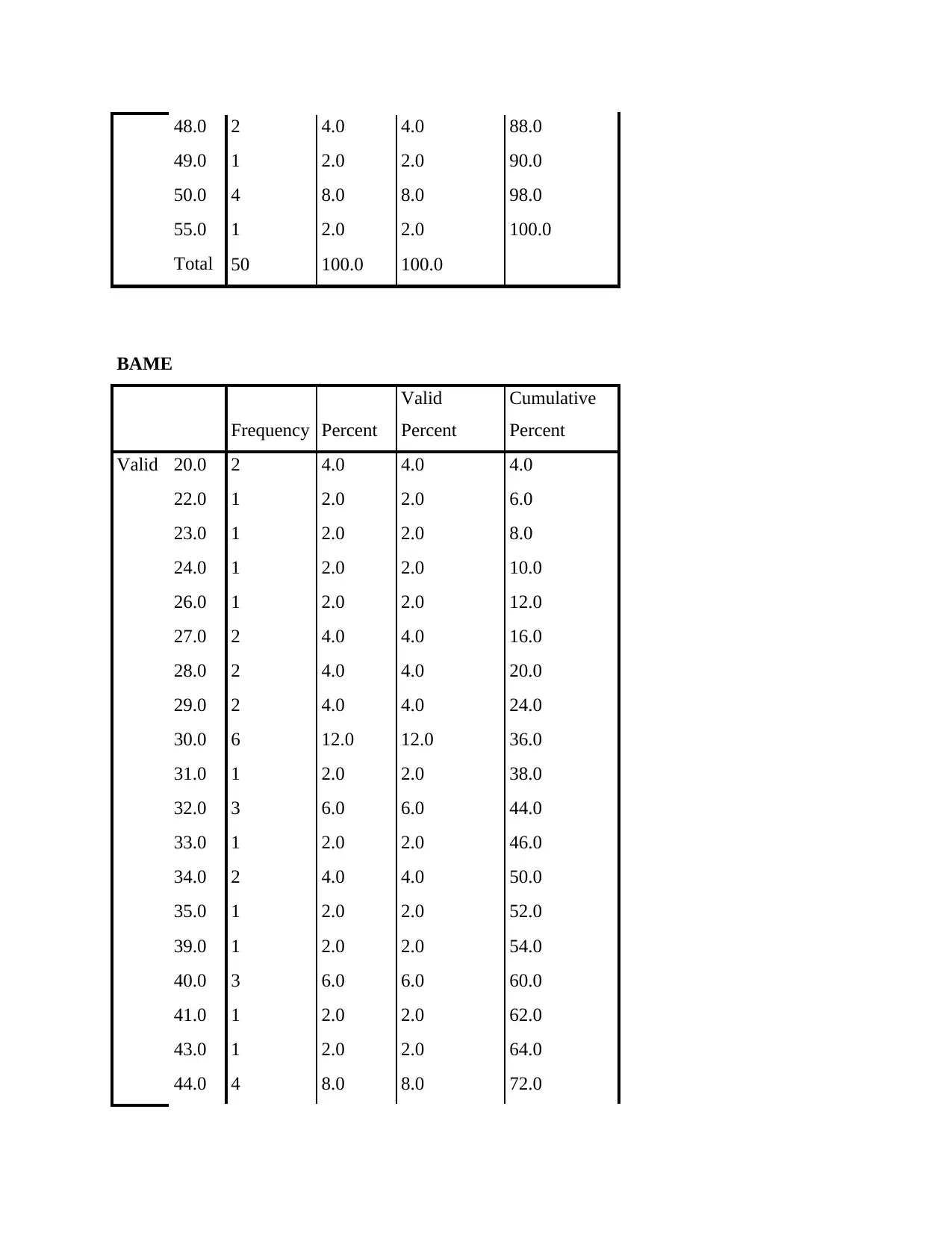
48.0 2 4.0 4.0 88.0
49.0 1 2.0 2.0 90.0
50.0 4 8.0 8.0 98.0
55.0 1 2.0 2.0 100.0
Total 50 100.0 100.0
BAME
Frequency Percent
Valid
Percent
Cumulative
Percent
Valid 20.0 2 4.0 4.0 4.0
22.0 1 2.0 2.0 6.0
23.0 1 2.0 2.0 8.0
24.0 1 2.0 2.0 10.0
26.0 1 2.0 2.0 12.0
27.0 2 4.0 4.0 16.0
28.0 2 4.0 4.0 20.0
29.0 2 4.0 4.0 24.0
30.0 6 12.0 12.0 36.0
31.0 1 2.0 2.0 38.0
32.0 3 6.0 6.0 44.0
33.0 1 2.0 2.0 46.0
34.0 2 4.0 4.0 50.0
35.0 1 2.0 2.0 52.0
39.0 1 2.0 2.0 54.0
40.0 3 6.0 6.0 60.0
41.0 1 2.0 2.0 62.0
43.0 1 2.0 2.0 64.0
44.0 4 8.0 8.0 72.0
49.0 1 2.0 2.0 90.0
50.0 4 8.0 8.0 98.0
55.0 1 2.0 2.0 100.0
Total 50 100.0 100.0
BAME
Frequency Percent
Valid
Percent
Cumulative
Percent
Valid 20.0 2 4.0 4.0 4.0
22.0 1 2.0 2.0 6.0
23.0 1 2.0 2.0 8.0
24.0 1 2.0 2.0 10.0
26.0 1 2.0 2.0 12.0
27.0 2 4.0 4.0 16.0
28.0 2 4.0 4.0 20.0
29.0 2 4.0 4.0 24.0
30.0 6 12.0 12.0 36.0
31.0 1 2.0 2.0 38.0
32.0 3 6.0 6.0 44.0
33.0 1 2.0 2.0 46.0
34.0 2 4.0 4.0 50.0
35.0 1 2.0 2.0 52.0
39.0 1 2.0 2.0 54.0
40.0 3 6.0 6.0 60.0
41.0 1 2.0 2.0 62.0
43.0 1 2.0 2.0 64.0
44.0 4 8.0 8.0 72.0
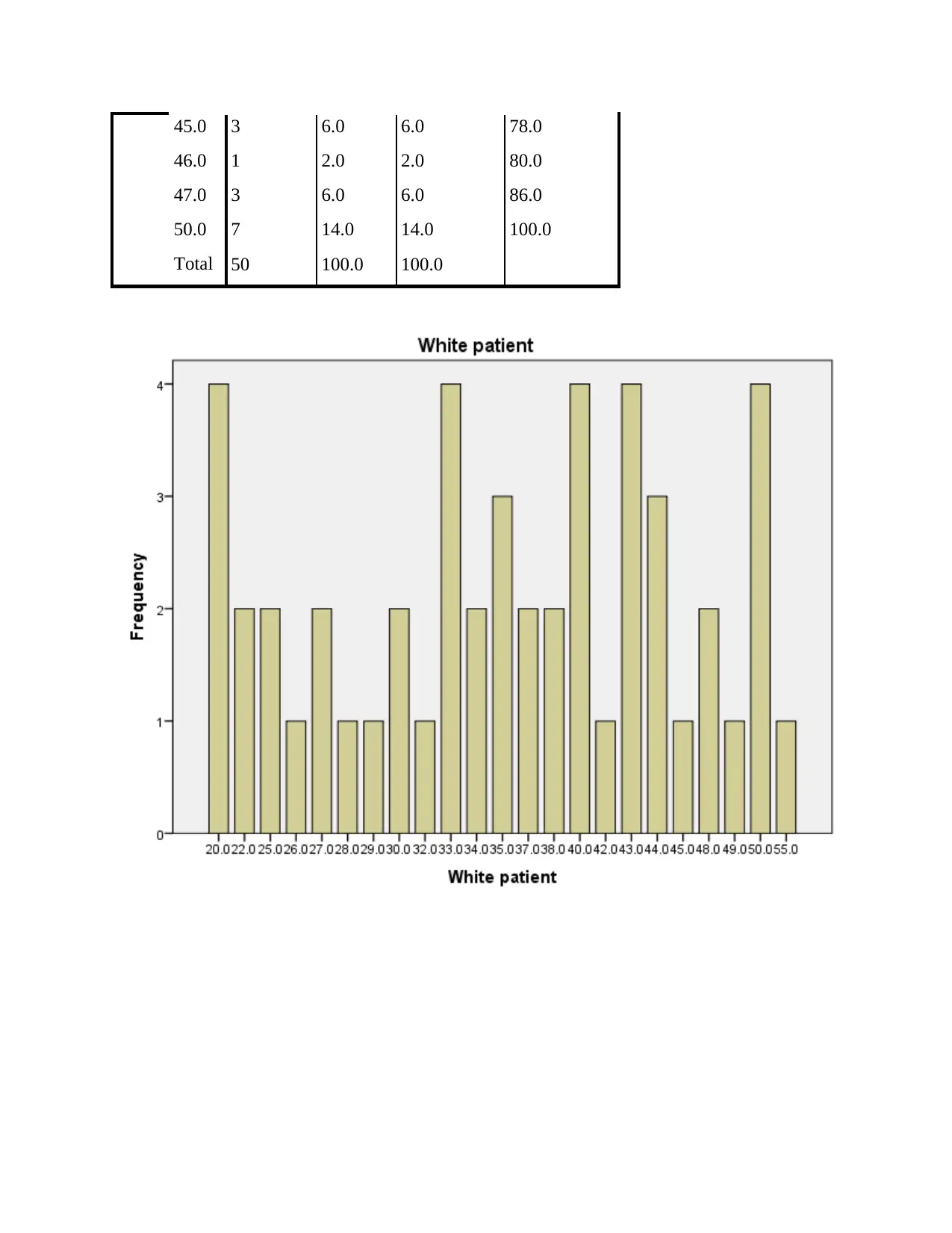
45.0 3 6.0 6.0 78.0
46.0 1 2.0 2.0 80.0
47.0 3 6.0 6.0 86.0
50.0 7 14.0 14.0 100.0
Total 50 100.0 100.0
46.0 1 2.0 2.0 80.0
47.0 3 6.0 6.0 86.0
50.0 7 14.0 14.0 100.0
Total 50 100.0 100.0
You're viewing a preview
Unlock full access by subscribing today!
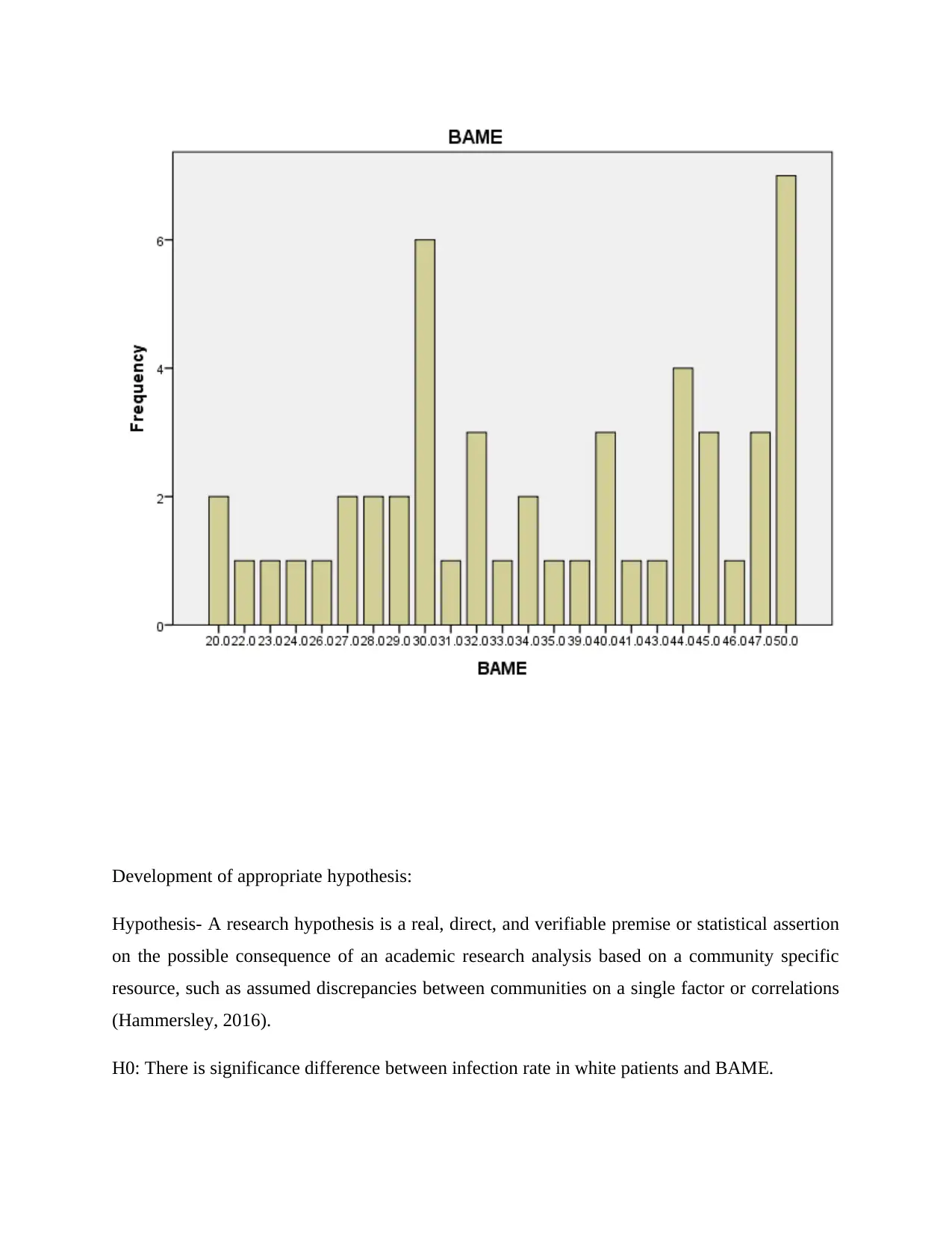
Development of appropriate hypothesis:
Hypothesis- A research hypothesis is a real, direct, and verifiable premise or statistical assertion
on the possible consequence of an academic research analysis based on a community specific
resource, such as assumed discrepancies between communities on a single factor or correlations
(Hammersley, 2016).
H0: There is significance difference between infection rate in white patients and BAME.
Hypothesis- A research hypothesis is a real, direct, and verifiable premise or statistical assertion
on the possible consequence of an academic research analysis based on a community specific
resource, such as assumed discrepancies between communities on a single factor or correlations
(Hammersley, 2016).
H0: There is significance difference between infection rate in white patients and BAME.
Paraphrase This Document
Need a fresh take? Get an instant paraphrase of this document with our AI Paraphraser
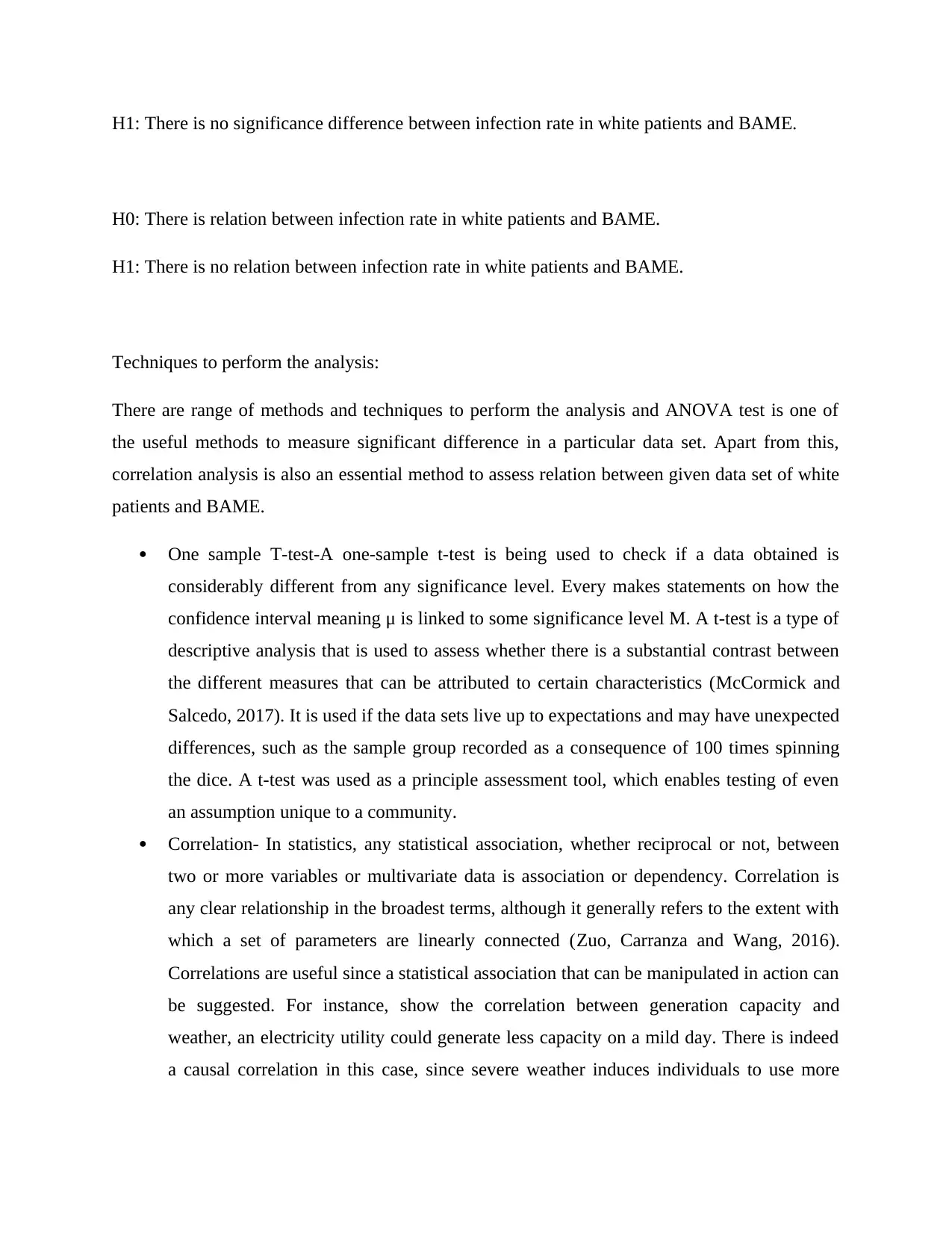
H1: There is no significance difference between infection rate in white patients and BAME.
H0: There is relation between infection rate in white patients and BAME.
H1: There is no relation between infection rate in white patients and BAME.
Techniques to perform the analysis:
There are range of methods and techniques to perform the analysis and ANOVA test is one of
the useful methods to measure significant difference in a particular data set. Apart from this,
correlation analysis is also an essential method to assess relation between given data set of white
patients and BAME.
One sample T-test-A one-sample t-test is being used to check if a data obtained is
considerably different from any significance level. Every makes statements on how the
confidence interval meaning μ is linked to some significance level M. A t-test is a type of
descriptive analysis that is used to assess whether there is a substantial contrast between
the different measures that can be attributed to certain characteristics (McCormick and
Salcedo, 2017). It is used if the data sets live up to expectations and may have unexpected
differences, such as the sample group recorded as a consequence of 100 times spinning
the dice. A t-test was used as a principle assessment tool, which enables testing of even
an assumption unique to a community.
Correlation- In statistics, any statistical association, whether reciprocal or not, between
two or more variables or multivariate data is association or dependency. Correlation is
any clear relationship in the broadest terms, although it generally refers to the extent with
which a set of parameters are linearly connected (Zuo, Carranza and Wang, 2016).
Correlations are useful since a statistical association that can be manipulated in action can
be suggested. For instance, show the correlation between generation capacity and
weather, an electricity utility could generate less capacity on a mild day. There is indeed
a causal correlation in this case, since severe weather induces individuals to use more
H0: There is relation between infection rate in white patients and BAME.
H1: There is no relation between infection rate in white patients and BAME.
Techniques to perform the analysis:
There are range of methods and techniques to perform the analysis and ANOVA test is one of
the useful methods to measure significant difference in a particular data set. Apart from this,
correlation analysis is also an essential method to assess relation between given data set of white
patients and BAME.
One sample T-test-A one-sample t-test is being used to check if a data obtained is
considerably different from any significance level. Every makes statements on how the
confidence interval meaning μ is linked to some significance level M. A t-test is a type of
descriptive analysis that is used to assess whether there is a substantial contrast between
the different measures that can be attributed to certain characteristics (McCormick and
Salcedo, 2017). It is used if the data sets live up to expectations and may have unexpected
differences, such as the sample group recorded as a consequence of 100 times spinning
the dice. A t-test was used as a principle assessment tool, which enables testing of even
an assumption unique to a community.
Correlation- In statistics, any statistical association, whether reciprocal or not, between
two or more variables or multivariate data is association or dependency. Correlation is
any clear relationship in the broadest terms, although it generally refers to the extent with
which a set of parameters are linearly connected (Zuo, Carranza and Wang, 2016).
Correlations are useful since a statistical association that can be manipulated in action can
be suggested. For instance, show the correlation between generation capacity and
weather, an electricity utility could generate less capacity on a mild day. There is indeed
a causal correlation in this case, since severe weather induces individuals to use more
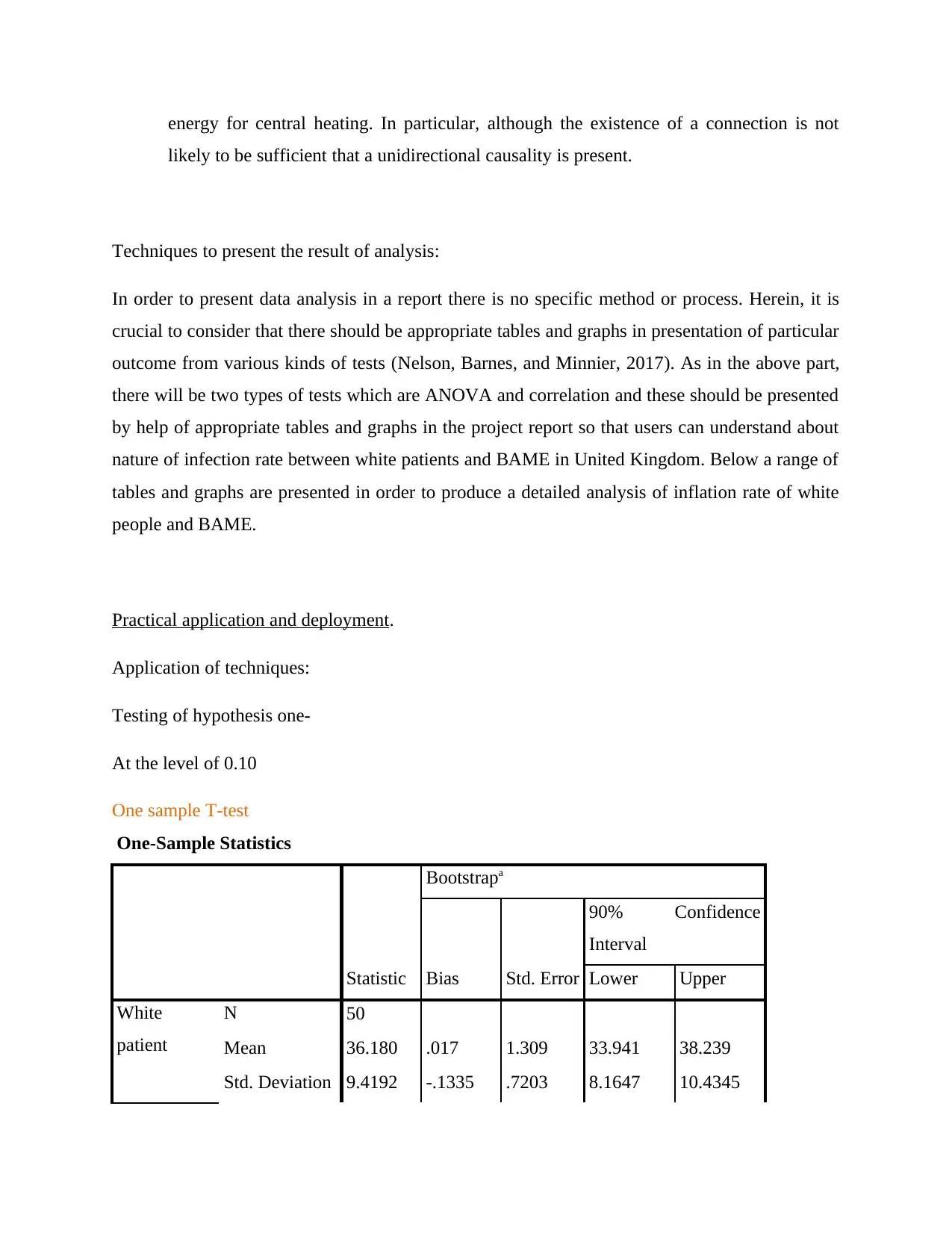
energy for central heating. In particular, although the existence of a connection is not
likely to be sufficient that a unidirectional causality is present.
Techniques to present the result of analysis:
In order to present data analysis in a report there is no specific method or process. Herein, it is
crucial to consider that there should be appropriate tables and graphs in presentation of particular
outcome from various kinds of tests (Nelson, Barnes, and Minnier, 2017). As in the above part,
there will be two types of tests which are ANOVA and correlation and these should be presented
by help of appropriate tables and graphs in the project report so that users can understand about
nature of infection rate between white patients and BAME in United Kingdom. Below a range of
tables and graphs are presented in order to produce a detailed analysis of inflation rate of white
people and BAME.
Practical application and deployment.
Application of techniques:
Testing of hypothesis one-
At the level of 0.10
One sample T-test
One-Sample Statistics
Statistic
Bootstrapa
Bias Std. Error
90% Confidence
Interval
Lower Upper
White
patient
N 50
Mean 36.180 .017 1.309 33.941 38.239
Std. Deviation 9.4192 -.1335 .7203 8.1647 10.4345
likely to be sufficient that a unidirectional causality is present.
Techniques to present the result of analysis:
In order to present data analysis in a report there is no specific method or process. Herein, it is
crucial to consider that there should be appropriate tables and graphs in presentation of particular
outcome from various kinds of tests (Nelson, Barnes, and Minnier, 2017). As in the above part,
there will be two types of tests which are ANOVA and correlation and these should be presented
by help of appropriate tables and graphs in the project report so that users can understand about
nature of infection rate between white patients and BAME in United Kingdom. Below a range of
tables and graphs are presented in order to produce a detailed analysis of inflation rate of white
people and BAME.
Practical application and deployment.
Application of techniques:
Testing of hypothesis one-
At the level of 0.10
One sample T-test
One-Sample Statistics
Statistic
Bootstrapa
Bias Std. Error
90% Confidence
Interval
Lower Upper
White
patient
N 50
Mean 36.180 .017 1.309 33.941 38.239
Std. Deviation 9.4192 -.1335 .7203 8.1647 10.4345
You're viewing a preview
Unlock full access by subscribing today!
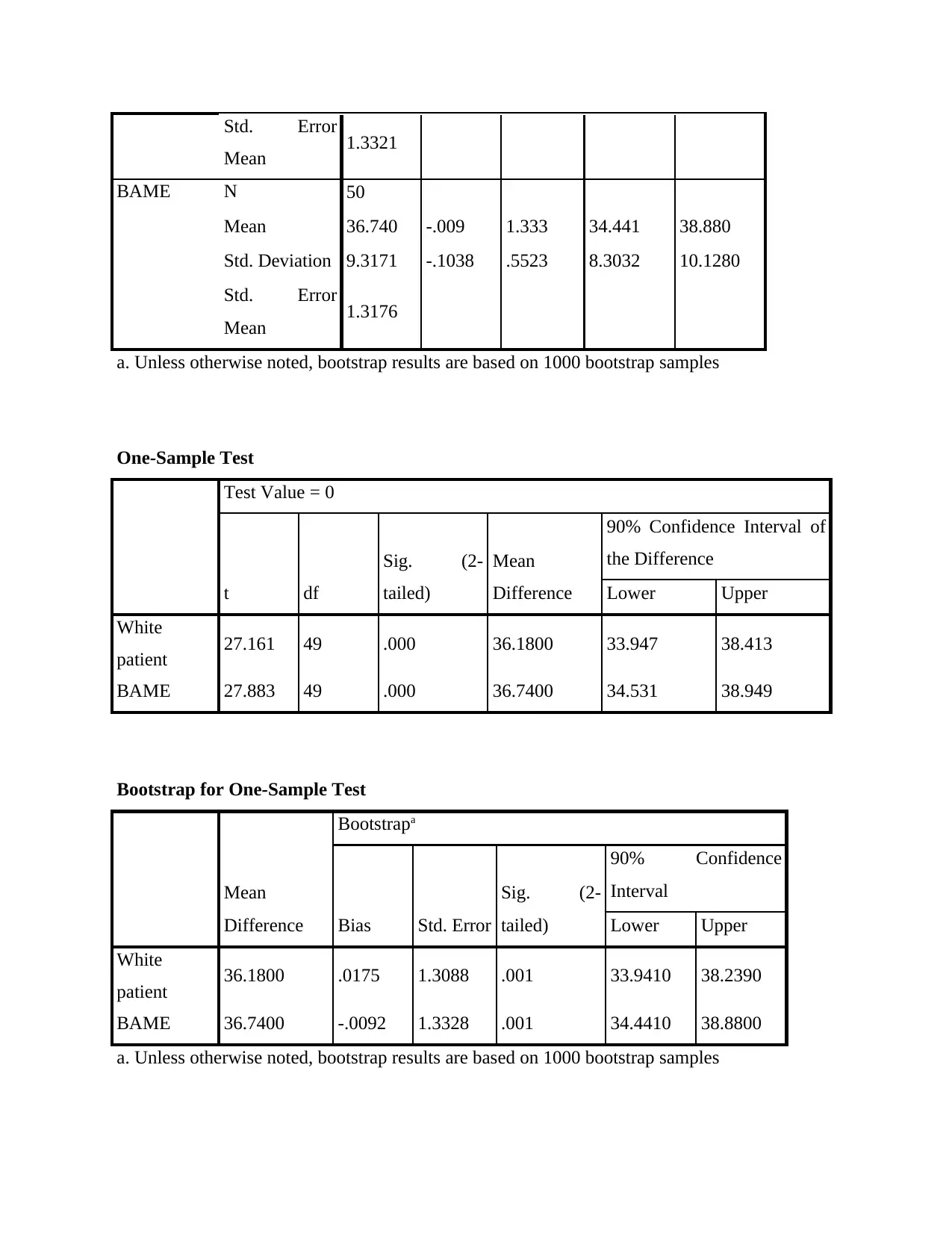
Std. Error
Mean 1.3321
BAME N 50
Mean 36.740 -.009 1.333 34.441 38.880
Std. Deviation 9.3171 -.1038 .5523 8.3032 10.1280
Std. Error
Mean 1.3176
a. Unless otherwise noted, bootstrap results are based on 1000 bootstrap samples
One-Sample Test
Test Value = 0
t df
Sig. (2-
tailed)
Mean
Difference
90% Confidence Interval of
the Difference
Lower Upper
White
patient 27.161 49 .000 36.1800 33.947 38.413
BAME 27.883 49 .000 36.7400 34.531 38.949
Bootstrap for One-Sample Test
Mean
Difference
Bootstrapa
Bias Std. Error
Sig. (2-
tailed)
90% Confidence
Interval
Lower Upper
White
patient 36.1800 .0175 1.3088 .001 33.9410 38.2390
BAME 36.7400 -.0092 1.3328 .001 34.4410 38.8800
a. Unless otherwise noted, bootstrap results are based on 1000 bootstrap samples
Mean 1.3321
BAME N 50
Mean 36.740 -.009 1.333 34.441 38.880
Std. Deviation 9.3171 -.1038 .5523 8.3032 10.1280
Std. Error
Mean 1.3176
a. Unless otherwise noted, bootstrap results are based on 1000 bootstrap samples
One-Sample Test
Test Value = 0
t df
Sig. (2-
tailed)
Mean
Difference
90% Confidence Interval of
the Difference
Lower Upper
White
patient 27.161 49 .000 36.1800 33.947 38.413
BAME 27.883 49 .000 36.7400 34.531 38.949
Bootstrap for One-Sample Test
Mean
Difference
Bootstrapa
Bias Std. Error
Sig. (2-
tailed)
90% Confidence
Interval
Lower Upper
White
patient 36.1800 .0175 1.3088 .001 33.9410 38.2390
BAME 36.7400 -.0092 1.3328 .001 34.4410 38.8800
a. Unless otherwise noted, bootstrap results are based on 1000 bootstrap samples
Paraphrase This Document
Need a fresh take? Get an instant paraphrase of this document with our AI Paraphraser

At the level of 0.01:
One-Sample Statistics
Statistic
Bootstrapa
Bias Std. Error
90% Confidence
Interval
Lower Upper
White
patient
N 50
Mean 36.180 .029 1.322 34.041 38.499
Std. Deviation 9.4192 -.1412 .7189 8.1234 10.4846
Std. Error
Mean 1.3321
BAME N 50
Mean 36.740 -.016 1.314 34.561 38.820
Std. Deviation 9.3171 -.1231 .5529 8.2384 10.0995
Std. Error
Mean 1.3176
a. Unless otherwise noted, bootstrap results are based on 1000 bootstrap samples
One-Sample Test
Test Value = 0
t df
Sig. (2-
tailed)
Mean
Difference
99.9% Confidence Interval
of the Difference
Lower Upper
White
patient 27.161 49 .000 36.1800 31.517 40.843
BAME 27.883 49 .000 36.7400 32.128 41.352
One-Sample Statistics
Statistic
Bootstrapa
Bias Std. Error
90% Confidence
Interval
Lower Upper
White
patient
N 50
Mean 36.180 .029 1.322 34.041 38.499
Std. Deviation 9.4192 -.1412 .7189 8.1234 10.4846
Std. Error
Mean 1.3321
BAME N 50
Mean 36.740 -.016 1.314 34.561 38.820
Std. Deviation 9.3171 -.1231 .5529 8.2384 10.0995
Std. Error
Mean 1.3176
a. Unless otherwise noted, bootstrap results are based on 1000 bootstrap samples
One-Sample Test
Test Value = 0
t df
Sig. (2-
tailed)
Mean
Difference
99.9% Confidence Interval
of the Difference
Lower Upper
White
patient 27.161 49 .000 36.1800 31.517 40.843
BAME 27.883 49 .000 36.7400 32.128 41.352

Bootstrap for One-Sample Test
Mean
Difference
Bootstrapa
Bias Std. Error
Sig. (2-
tailed)
90% Confidence
Interval
Lower Upper
White
patient 36.1800 .0294 1.3218 .001 34.0410 38.4990
BAME 36.7400 -.0160 1.3143 .001 34.5610 38.8200
a. Unless otherwise noted, bootstrap results are based on 1000 bootstrap samples
At the level of 0.02
One-Sample Statistics
Statistic
Bootstrapa
Bias Std. Error
90% Confidence
Interval
Lower Upper
White
patient
N 50
Mean 36.180 .004 1.258 34.140 38.299
Std. Deviation 9.4192 -.1164 .6726 8.1665 10.4398
Std. Error
Mean 1.3321
BAME N 50
Mean 36.740 -.008 1.305 34.501 38.840
Std. Deviation 9.3171 -.1215 .5635 8.1801 10.1315
Mean
Difference
Bootstrapa
Bias Std. Error
Sig. (2-
tailed)
90% Confidence
Interval
Lower Upper
White
patient 36.1800 .0294 1.3218 .001 34.0410 38.4990
BAME 36.7400 -.0160 1.3143 .001 34.5610 38.8200
a. Unless otherwise noted, bootstrap results are based on 1000 bootstrap samples
At the level of 0.02
One-Sample Statistics
Statistic
Bootstrapa
Bias Std. Error
90% Confidence
Interval
Lower Upper
White
patient
N 50
Mean 36.180 .004 1.258 34.140 38.299
Std. Deviation 9.4192 -.1164 .6726 8.1665 10.4398
Std. Error
Mean 1.3321
BAME N 50
Mean 36.740 -.008 1.305 34.501 38.840
Std. Deviation 9.3171 -.1215 .5635 8.1801 10.1315
You're viewing a preview
Unlock full access by subscribing today!
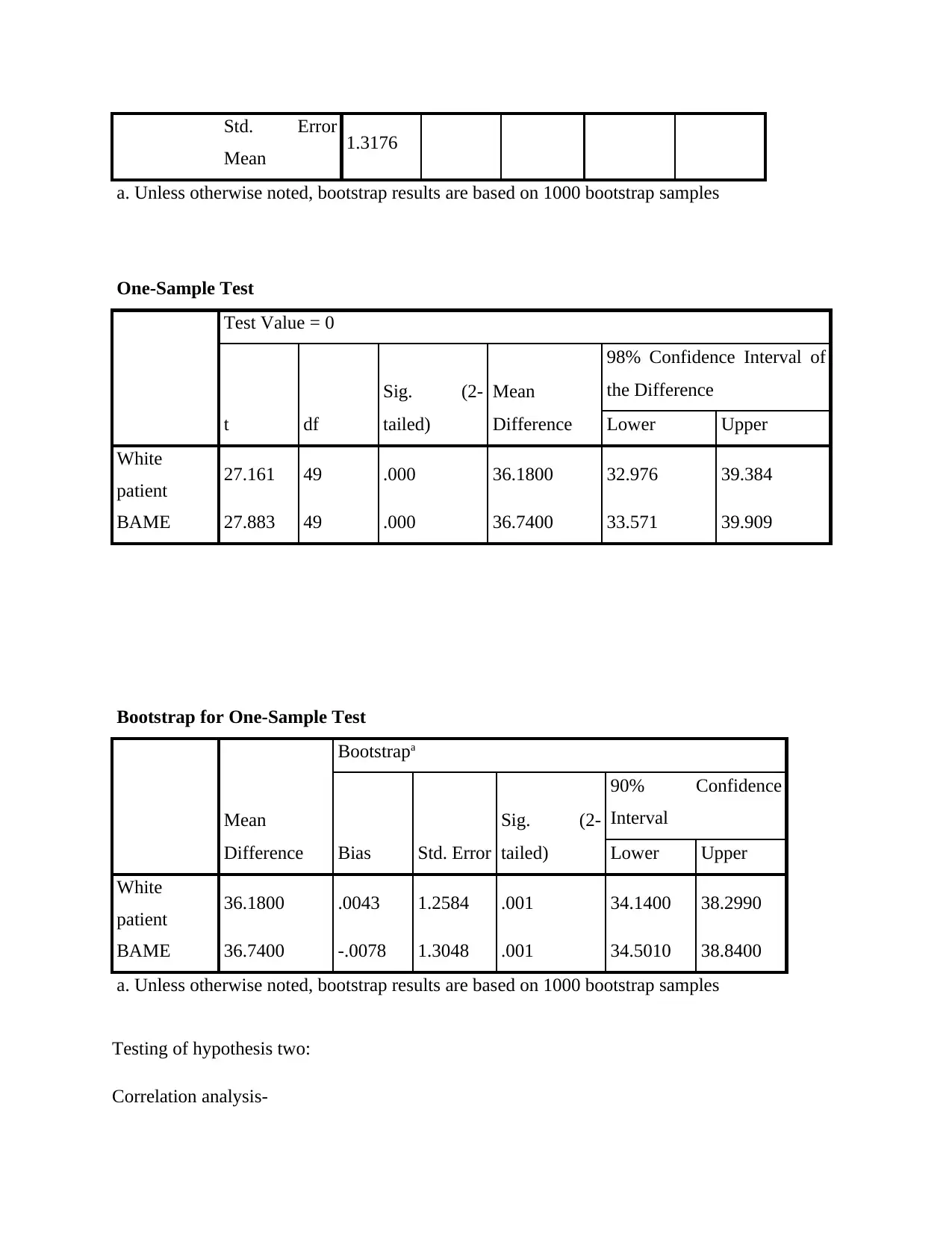
Std. Error
Mean 1.3176
a. Unless otherwise noted, bootstrap results are based on 1000 bootstrap samples
One-Sample Test
Test Value = 0
t df
Sig. (2-
tailed)
Mean
Difference
98% Confidence Interval of
the Difference
Lower Upper
White
patient 27.161 49 .000 36.1800 32.976 39.384
BAME 27.883 49 .000 36.7400 33.571 39.909
Bootstrap for One-Sample Test
Mean
Difference
Bootstrapa
Bias Std. Error
Sig. (2-
tailed)
90% Confidence
Interval
Lower Upper
White
patient 36.1800 .0043 1.2584 .001 34.1400 38.2990
BAME 36.7400 -.0078 1.3048 .001 34.5010 38.8400
a. Unless otherwise noted, bootstrap results are based on 1000 bootstrap samples
Testing of hypothesis two:
Correlation analysis-
Mean 1.3176
a. Unless otherwise noted, bootstrap results are based on 1000 bootstrap samples
One-Sample Test
Test Value = 0
t df
Sig. (2-
tailed)
Mean
Difference
98% Confidence Interval of
the Difference
Lower Upper
White
patient 27.161 49 .000 36.1800 32.976 39.384
BAME 27.883 49 .000 36.7400 33.571 39.909
Bootstrap for One-Sample Test
Mean
Difference
Bootstrapa
Bias Std. Error
Sig. (2-
tailed)
90% Confidence
Interval
Lower Upper
White
patient 36.1800 .0043 1.2584 .001 34.1400 38.2990
BAME 36.7400 -.0078 1.3048 .001 34.5010 38.8400
a. Unless otherwise noted, bootstrap results are based on 1000 bootstrap samples
Testing of hypothesis two:
Correlation analysis-
Paraphrase This Document
Need a fresh take? Get an instant paraphrase of this document with our AI Paraphraser
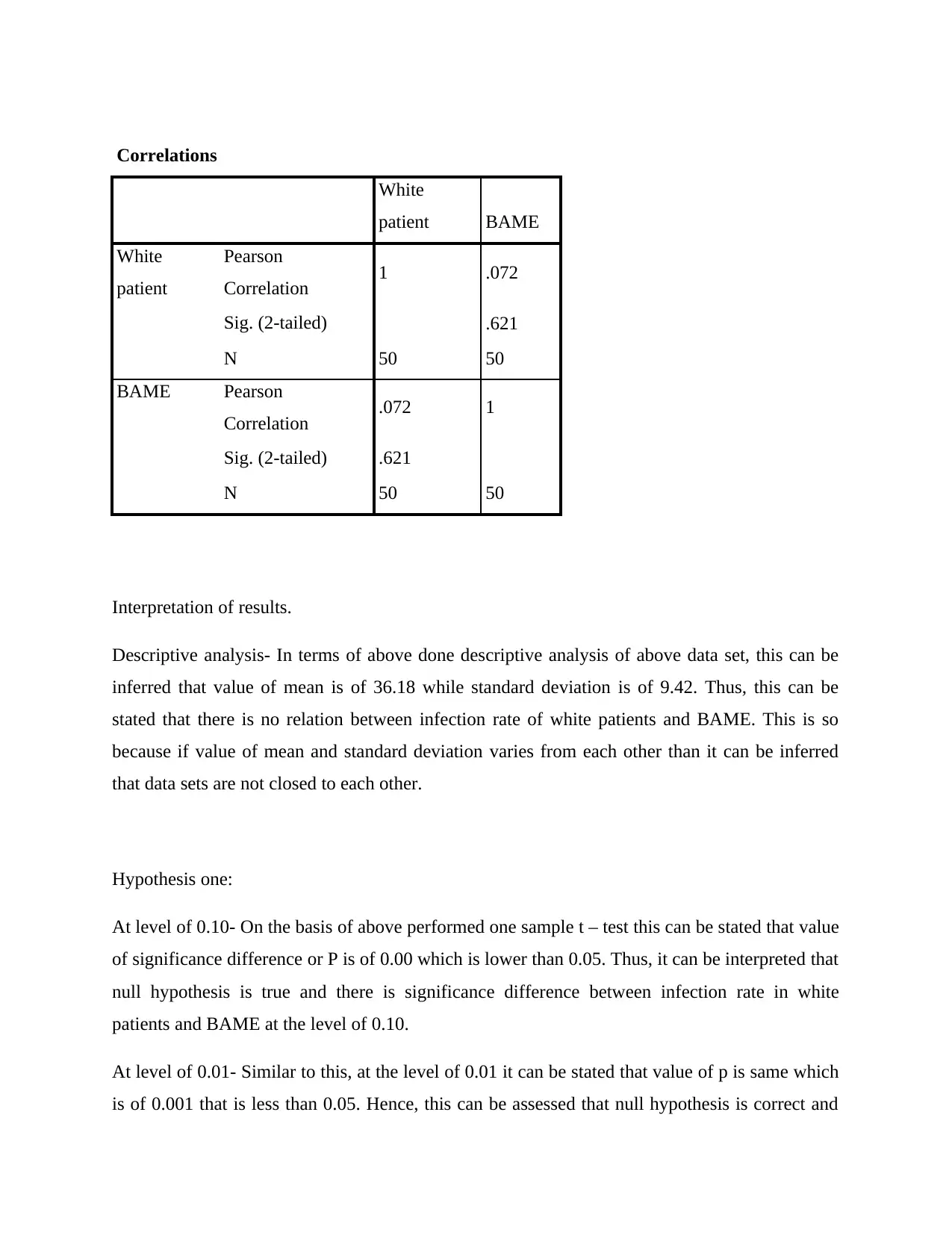
Correlations
White
patient BAME
White
patient
Pearson
Correlation 1 .072
Sig. (2-tailed) .621
N 50 50
BAME Pearson
Correlation .072 1
Sig. (2-tailed) .621
N 50 50
Interpretation of results.
Descriptive analysis- In terms of above done descriptive analysis of above data set, this can be
inferred that value of mean is of 36.18 while standard deviation is of 9.42. Thus, this can be
stated that there is no relation between infection rate of white patients and BAME. This is so
because if value of mean and standard deviation varies from each other than it can be inferred
that data sets are not closed to each other.
Hypothesis one:
At level of 0.10- On the basis of above performed one sample t – test this can be stated that value
of significance difference or P is of 0.00 which is lower than 0.05. Thus, it can be interpreted that
null hypothesis is true and there is significance difference between infection rate in white
patients and BAME at the level of 0.10.
At level of 0.01- Similar to this, at the level of 0.01 it can be stated that value of p is same which
is of 0.001 that is less than 0.05. Hence, this can be assessed that null hypothesis is correct and
White
patient BAME
White
patient
Pearson
Correlation 1 .072
Sig. (2-tailed) .621
N 50 50
BAME Pearson
Correlation .072 1
Sig. (2-tailed) .621
N 50 50
Interpretation of results.
Descriptive analysis- In terms of above done descriptive analysis of above data set, this can be
inferred that value of mean is of 36.18 while standard deviation is of 9.42. Thus, this can be
stated that there is no relation between infection rate of white patients and BAME. This is so
because if value of mean and standard deviation varies from each other than it can be inferred
that data sets are not closed to each other.
Hypothesis one:
At level of 0.10- On the basis of above performed one sample t – test this can be stated that value
of significance difference or P is of 0.00 which is lower than 0.05. Thus, it can be interpreted that
null hypothesis is true and there is significance difference between infection rate in white
patients and BAME at the level of 0.10.
At level of 0.01- Similar to this, at the level of 0.01 it can be stated that value of p is same which
is of 0.001 that is less than 0.05. Hence, this can be assessed that null hypothesis is correct and
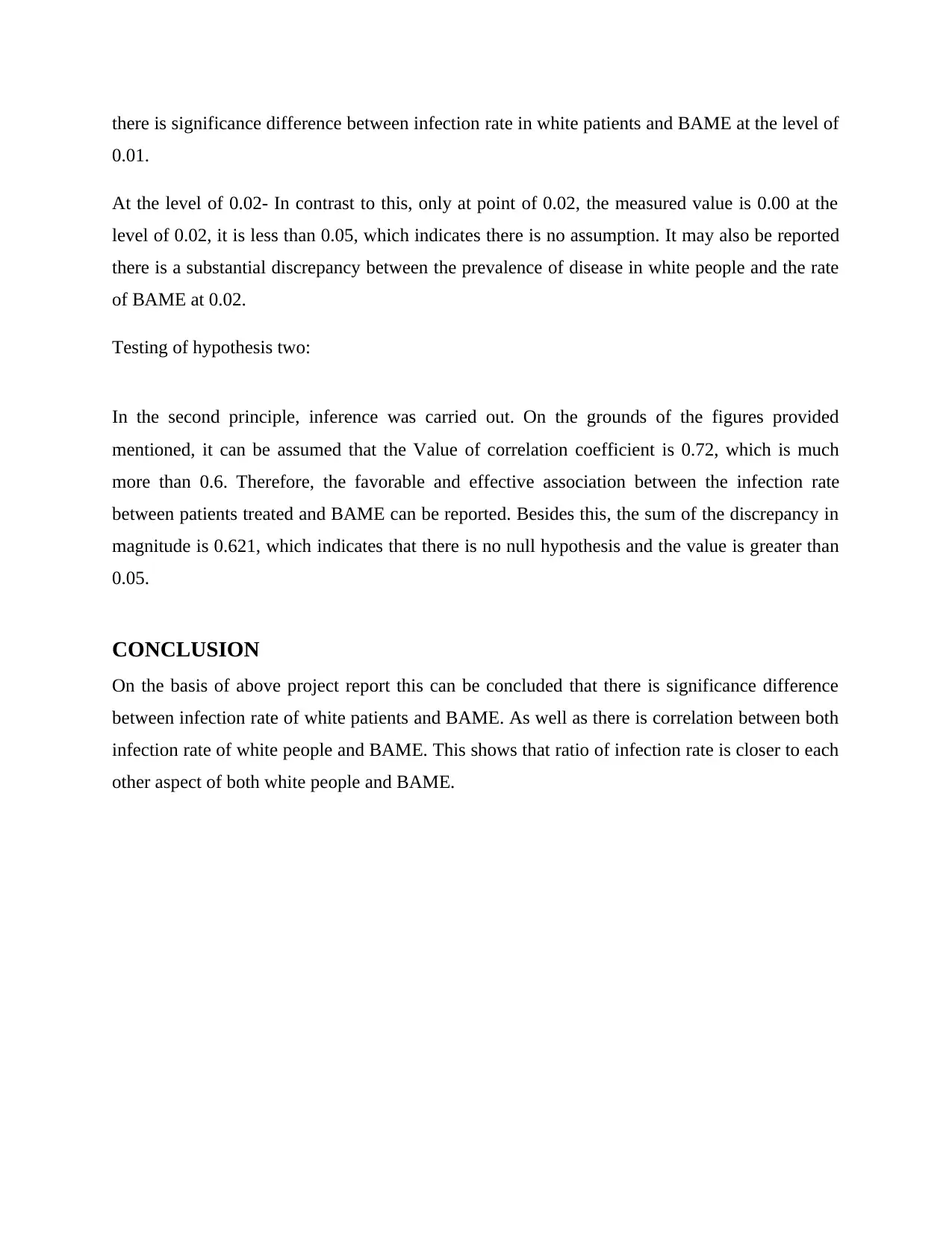
there is significance difference between infection rate in white patients and BAME at the level of
0.01.
At the level of 0.02- In contrast to this, only at point of 0.02, the measured value is 0.00 at the
level of 0.02, it is less than 0.05, which indicates there is no assumption. It may also be reported
there is a substantial discrepancy between the prevalence of disease in white people and the rate
of BAME at 0.02.
Testing of hypothesis two:
In the second principle, inference was carried out. On the grounds of the figures provided
mentioned, it can be assumed that the Value of correlation coefficient is 0.72, which is much
more than 0.6. Therefore, the favorable and effective association between the infection rate
between patients treated and BAME can be reported. Besides this, the sum of the discrepancy in
magnitude is 0.621, which indicates that there is no null hypothesis and the value is greater than
0.05.
CONCLUSION
On the basis of above project report this can be concluded that there is significance difference
between infection rate of white patients and BAME. As well as there is correlation between both
infection rate of white people and BAME. This shows that ratio of infection rate is closer to each
other aspect of both white people and BAME.
0.01.
At the level of 0.02- In contrast to this, only at point of 0.02, the measured value is 0.00 at the
level of 0.02, it is less than 0.05, which indicates there is no assumption. It may also be reported
there is a substantial discrepancy between the prevalence of disease in white people and the rate
of BAME at 0.02.
Testing of hypothesis two:
In the second principle, inference was carried out. On the grounds of the figures provided
mentioned, it can be assumed that the Value of correlation coefficient is 0.72, which is much
more than 0.6. Therefore, the favorable and effective association between the infection rate
between patients treated and BAME can be reported. Besides this, the sum of the discrepancy in
magnitude is 0.621, which indicates that there is no null hypothesis and the value is greater than
0.05.
CONCLUSION
On the basis of above project report this can be concluded that there is significance difference
between infection rate of white patients and BAME. As well as there is correlation between both
infection rate of white people and BAME. This shows that ratio of infection rate is closer to each
other aspect of both white people and BAME.
You're viewing a preview
Unlock full access by subscribing today!
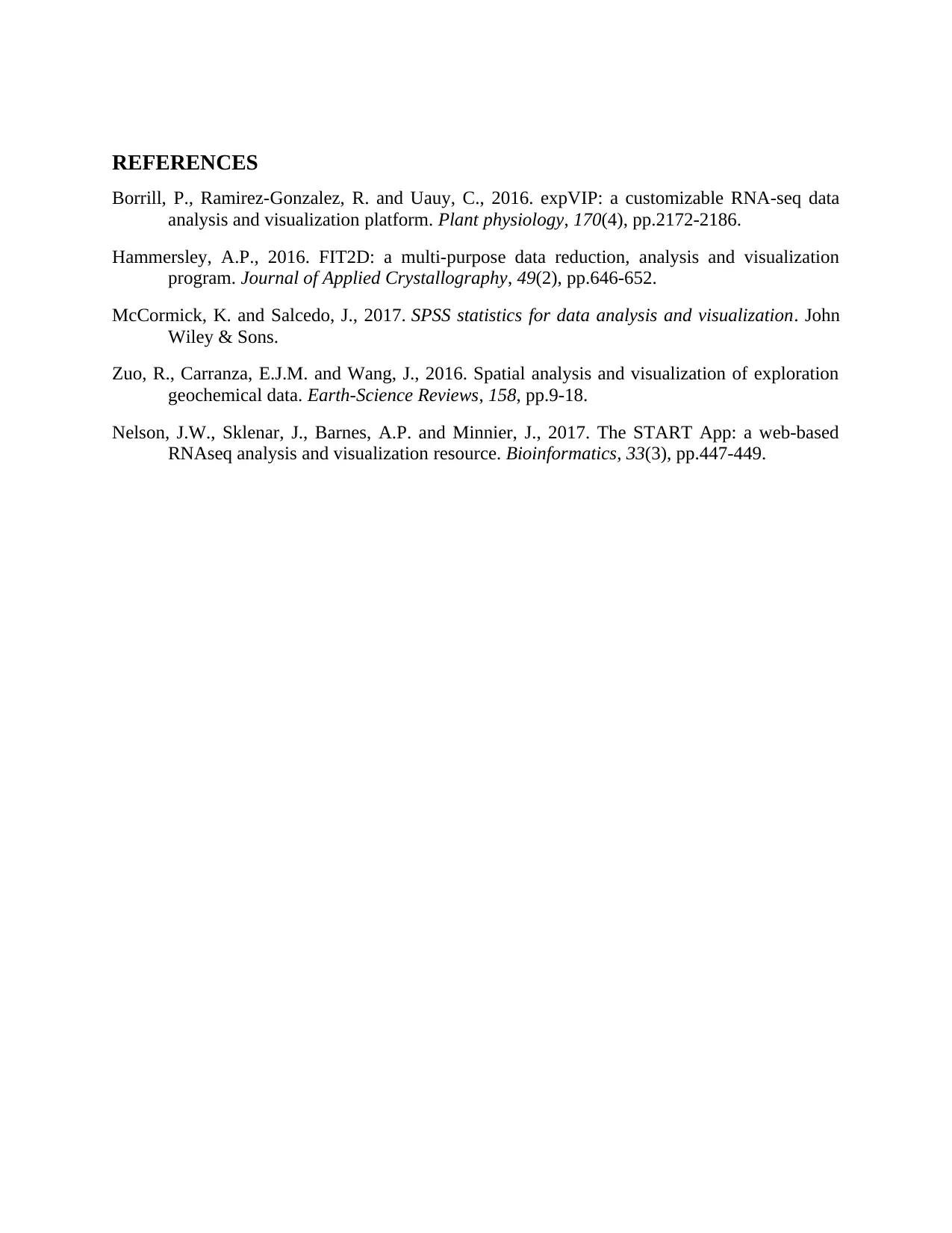
REFERENCES
Borrill, P., Ramirez-Gonzalez, R. and Uauy, C., 2016. expVIP: a customizable RNA-seq data
analysis and visualization platform. Plant physiology, 170(4), pp.2172-2186.
Hammersley, A.P., 2016. FIT2D: a multi-purpose data reduction, analysis and visualization
program. Journal of Applied Crystallography, 49(2), pp.646-652.
McCormick, K. and Salcedo, J., 2017. SPSS statistics for data analysis and visualization. John
Wiley & Sons.
Zuo, R., Carranza, E.J.M. and Wang, J., 2016. Spatial analysis and visualization of exploration
geochemical data. Earth-Science Reviews, 158, pp.9-18.
Nelson, J.W., Sklenar, J., Barnes, A.P. and Minnier, J., 2017. The START App: a web-based
RNAseq analysis and visualization resource. Bioinformatics, 33(3), pp.447-449.
Borrill, P., Ramirez-Gonzalez, R. and Uauy, C., 2016. expVIP: a customizable RNA-seq data
analysis and visualization platform. Plant physiology, 170(4), pp.2172-2186.
Hammersley, A.P., 2016. FIT2D: a multi-purpose data reduction, analysis and visualization
program. Journal of Applied Crystallography, 49(2), pp.646-652.
McCormick, K. and Salcedo, J., 2017. SPSS statistics for data analysis and visualization. John
Wiley & Sons.
Zuo, R., Carranza, E.J.M. and Wang, J., 2016. Spatial analysis and visualization of exploration
geochemical data. Earth-Science Reviews, 158, pp.9-18.
Nelson, J.W., Sklenar, J., Barnes, A.P. and Minnier, J., 2017. The START App: a web-based
RNAseq analysis and visualization resource. Bioinformatics, 33(3), pp.447-449.
1 out of 16
Related Documents
Your All-in-One AI-Powered Toolkit for Academic Success.
+13062052269
info@desklib.com
Available 24*7 on WhatsApp / Email
![[object Object]](/_next/static/media/star-bottom.7253800d.svg)
Unlock your academic potential
© 2024 | Zucol Services PVT LTD | All rights reserved.





